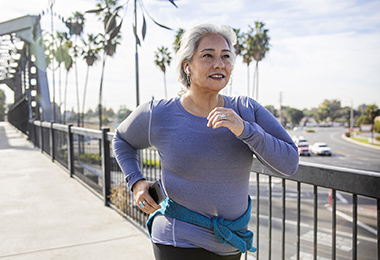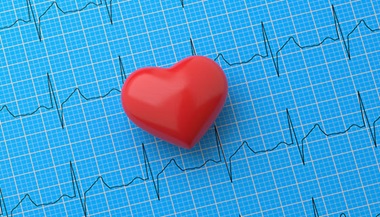Atrial Fibrillation: Prevention, Treatment and Research
Featured Experts:
Overview
Atrial fibrillation (often called “A-fib” or AF) is the most common type of abnormal heartbeat. In a normal heartbeat, the four chambers of the heart work in a steady, rhythmic way. With atrial fibrillation, disorganized electrical signals cause the upper two chambers of the heart (the atria) to quiver, contracting in a very fast (often more than 300 beats per minute) and irregular way (fibrillating)—hence the name. In turn, that rapid and irregular upper chamber beating causes the lower chamber to beat more rapidly than normal, also in an irregular way. In some patients the atrial fibrillation causes the lower chamber to beat faster than 100 to 175 beats per minute (bpm). A normal heartbeat, in contrast, is very regular and beats at about 60 bpm at rest.
“It’s best to consider atrial fibrillation as a medical condition rather than a disease,” says Johns Hopkins cardiologist Hugh Calkins, M.D. “The more patients learn about this condition, the better equipped they are to be active partners in management.”
Atrial fibrillation can be a dangerous condition because it dramatically increases the risk of stroke, by as much as fivefold. Most strokes that are caused by atrial fibrillation result in permanent disability or death.
About 15 percent to 20 percent of all strokes are due to A-fib. What happens is this: Like a sponge that doesn’t get completely wrung out or emptied, the heart of a person with A-fib is unable to move blood fully from chamber to chamber, raising the risk of clotting. A clot can then be pumped to the brain, causing a type of stroke called embolic stroke.
Inefficient pumping can also cause another, but less common, condition called heart failure. In this case, the heart beats inefficiently, causing blood to back up in the heart and resulting in fluid in the lungs, says Calkins.
In addition to heart failure, atrial fibrillation has been linked to dementia. This may be related to multiple small strokes that affect the memory centers of the brain.
About 2.7 million Americans have been diagnosed with atrial fibrillation. Even more have the condition but aren’t aware of symptoms.
Prevention
Not all cases of atrial fibrillation can be prevented. By taking steps to avoid coronary artery disease or high blood pressure, however, you can help avoid developing A-fib due to these causes. The basics include not smoking, following a heart-healthy Mediterranean-style diet (high in plant-based foods, fruits and vegetables, and low in saturated fats), being physically active and keeping to a normal weight (as indicated on a body-mass index chart).
AFib Treatment at Johns Hopkins
- Heart disease specialists oversee your care.
- Treatments are informed by the latest research.
- Care available throughout the Baltimore and Washington, D.C., metro areas.

Diagnosis
Atrial fibrillation is a progressive condition that tends to worsen over time. It’s important to know that atrial fibrillation sometimes causes no symptoms at all. The condition may be diagnosed after complaints of symptoms lead to an examination and tests, or it may be discovered during testing for other heart conditions. Your doctor will try to pinpoint what’s causing it.
Tests used to diagnose atrial fibrillation include:
-
Electrocardiogram (ECG or EKG): This test, which evaluates the heart’s electrical activity, can usually confirm the condition.
-
Holter monitor : This portable monitor tracks the heart’s electrical activity over 24 to 48 hours. It’s useful because some people are not in atrial fibrillation all the time. While wearing the monitor, you go about your normal activities. Some monitors can be worn for longer (an event monitor is usually work for four weeks) — they start tracking when irregular activity in the heart is detected .
-
Stress test : A “treadmill test” (so called because it’s typically done using one) checks the heart when it has to pump hard and faster during exercise.
-
Echocardiogram (transthoracic echocardiogram): This test uses sound waves to create a moving picture of the heart and evaluate the size of the atria and the overall heart function.
-
Transesophageal echocardiogram : Because it’s easier to see the atria of the heart through the esophagus (the canal that connects the mouth, throat and stomach), this sound wave test is administered through the throat. “It’s useful in detecting if a blood clot has formed in the atrium prior to a cardioversion procedure,” Calkins says.
-
Chest X-ray : An X-ray is used to see complications of A-fib in the heart and lungs.
-
Blood tests : The results may be used to evaluate heart markers, like cholesterol, as well as thyroid and electrolyte levels.
Treatment
“With the latest medical options, including new blood-thinning medications and catheter ablation [radiofrequency energy sent to the heart via thin wires guided through blood vessels] of atrial fibrillation, AF patients are getting the best treatments ever,” Calkins says.
How atrial fibrillation is treated depends on the underlying cause, and on the frequency and severity of symptoms. In general, your doctor aims to:
-
Reduce your risk of stroke. Most people need a type of blood-thinner medication (such as warfarin, apixaban, rivaroxaban or dabigatran) to reduce the risk of clotting. With warfarin, frequent blood checks are needed to monitor effectiveness and dose, but this is not required for the newer blood thinners, says Calkins. Medication decisions are based on assessment of your stroke risk. Most patients with AF who are over age 65 require a blood thinner, Calkins says.
-
New Treatment Option. If you are unable to take a blood thinner because of risk of bleeding or falls, your doctor may recommend a procedure to occlude your left atrial appendage. Find out more about these options here .
-
Manage “rate control.” That’s the rate at which the lower chambers of the heart are beating. Medications that do this include beta-blockers.
-
Restore a normal heart rhythm. If symptoms persist despite having a controlled heart rate, efforts to restore and maintain the heart’s rhythm are often undertaken. One way normal rhythm can be restored is with a procedure called electrical cardioversion. Anti-arrhythmic medications can also be used. If these options are ineffective, catheter ablation can be performed. This procedure is used to eliminate atrial fibrillation by cauterizing certain areas in the heart that cause atrial fibrillation, says Calkins. Your doctor can explain this procedure to you in more detail.
-
Treat any underlying disorder, such as a thyroid problem or high blood pressure. For heart problems, lifestyle changes that improve weight and blood markers—a heart-healthy diet, being more active and losing weight if needed—can help. Medications may be given to manage certain conditions. In some cases, surgery is needed to repair damaged arteries (if there’s coronary artery disease) or heart valves (if there’s rheumatic heart disease).
Living With Atrial Fibrillation
Having A-fib and not knowing when quivering episodes will start may cause you stress. But by carefully managing your condition, you’ll feel better physically and mentally. Many people with this disorder lead normal, active lives.
“The main concern in patients with AF is stroke,” Calkins says. “It’s important that you meet with your physician and determine if your stroke risk warrants treatment with a blood-thinning medication. This is the single most important aspect of AF management.”
-
Be sure to follow medication guidelines carefully. When you take a blood-thinner called warfarin, you need to have your blood checked monthly to evaluate effectiveness. Don’t double up on a dose if you miss one—consult your doctor. With all blood thinners, you can bleed more easily, so let your doctor know if you notice any unusual bruising or bleeding. Your doctor may also advise dietary changes when taking blood thinners, such as avoiding intermittent larger servings of dark leafy greens: It is much better to eat a consistent amount of green leafy vegetables on a near daily basis.
-
Keep a symptom record. In a notebook, write down when you experience quivering episodes and how long they last, as well as any other symptoms. Bring this information to doctor visits. One way to check if you’re having palpitations is putting two fingers on the artery on the underside of your wrist to feel your pulse. You may be able to detect palpitations if the beating is faster or more irregular than usual, such as skipping beats.
-
Learn your “triggers.” Keeping a record may also help you identify causes that set off an irregular heartbeat. Common triggers for people with A-fib include stress, drinking alcohol or caffeine, doing certain exercises and consuming foods that contain the flavor enhancer monosodium glutamate (MSG). Being aware of these triggers can help you avoid them.
Research
Johns Hopkins researchers have added much to the understanding of what causes atrial fibrillation and how to manage it. Among their accomplishments:
They defined the guidelines indicating which symptoms call for the use of catheter and surgical ablation of atrial fibrillation, based on the type of AF, the patient’s symptoms and the response to anti-arrhythmic drug therapy. These guidelines help doctors deliver the best, most up-to-date treatments. Calkins was the lead author of the Expert Consensus Statement on Catheter and Surgical Ablation of Atrial Fibrillation, published by the Heart Rhythm Society.
Johns Hopkins clinicians also helped to define the indications, techniques and outcomes of atrial fibrillation ablation, in the above expert consensus statement.
They learned that people with a history of sudden drops in blood pressure are at increased risk for later A-fib. A Johns Hopkins-led study found that those who experience orthostatic hypotension—a sudden drop in blood pressure when going from lying down to standing—have a 40 percent increase in their risk of developing atrial fibrillation over the next two decades, an important possible early warning sign.







